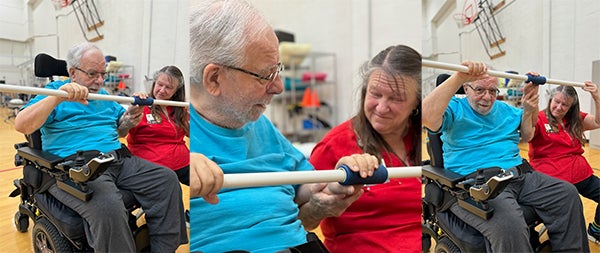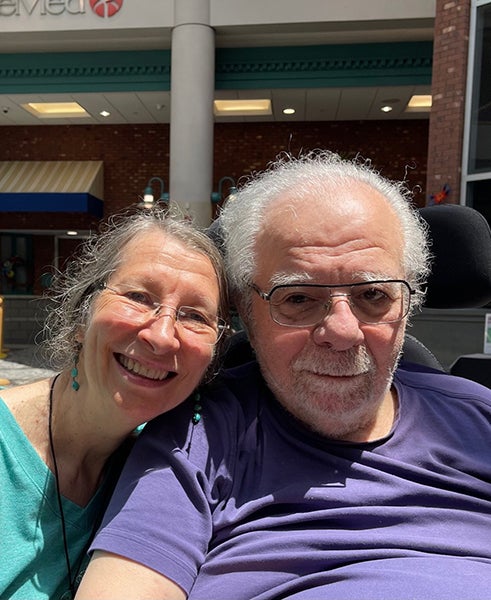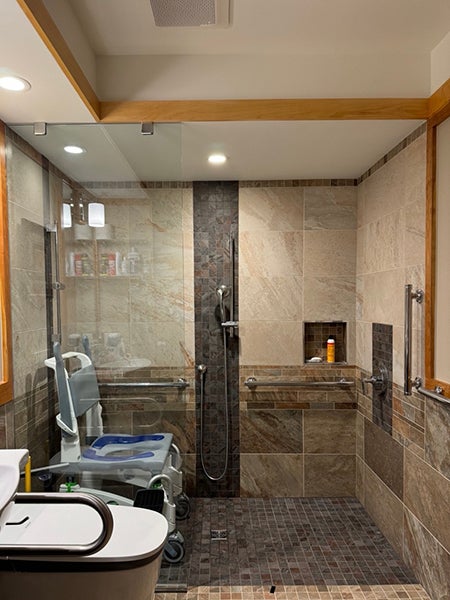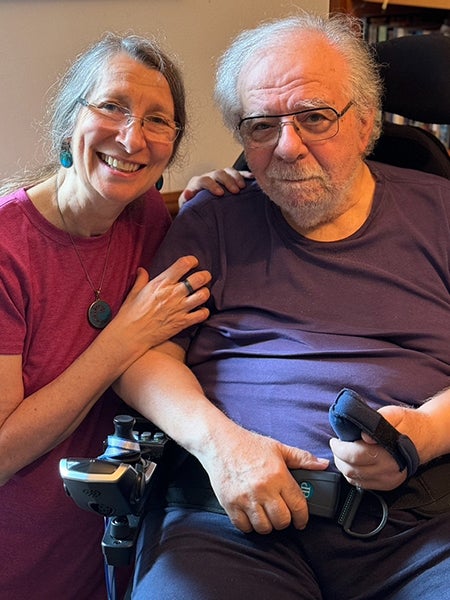Aging in Place: Al Urzi and Sarah Susanka on Life after Stroke
September 18, 2024According to the Stroke Foundation, "Fifteen million people worldwide are affected by stroke. Of those, an estimated 50 percent will live with permanent or chronic disability."
Al Urzi, a spiritual counselor and teacher and his wife, Sarah Susanka, a renowned architect and fellow teacher, were thrown into the world of stroke and disability in a matter of moments one unsuspecting evening.
Signs of a Stroke
On January 16, 2024, they were enjoying dinner when Al experienced sudden onset symptoms:
- His face drooped.
- He slumped to the right.
- He began violently coughing as he choked on corn.
- His speech became garbled.
Sarah recalls, "I said to Al, 'Oh my! You're having a stroke.' He replied that he was not, except his words were not clear."
Swift and Expert Care
Sarah immediately called 911. Within moments, emergency medical services (EMS) was on the scene and whisked Al to WakeMed Raleigh Campus, a Joint Commission-Thrombectomy Capable Stroke Center, via ambulance.
"They arrived within minutes and took Al on a stretcher because he had lost some functionality. He wasn’t able to walk or move his body in the normal way," Sarah remembers. "They encouraged us to select WakeMed. We were happy to do so, as we’d had good experiences there in the past."
Al's computed tomography (CT) scan revealed an ischemic stroke. The stroke team stepped into action, administering thrombolytics and alteplase to halt the progression of his stroke. He also had an intra-arterial mechanical thrombectomy to remove brain clot, though they were unable to stent it. Al's disability was significant, and he was not quite strong enough to enter the WakeMed Rehabilitation Hospital after ten days in the hospital, so he was transferred to a skilled nursing facility to regain some strength.
Sarah shares, "Forty-five days after entering the skilled nursing facility, he wasn't eating or drinking much, so the care team decided he would need a gastrointestinal tube for nutrients and liquids. That's when he finally started improving."
Entry into the WakeMed Rehabilitation Hospital
Toward the end of April 2024, Al was finally strong enough to gain admittance into the WakeMed Rehabilitation inpatient program.

Admissions supervisor, Melanie Boyette explains, "They were both so very excited to be accepted for rehabilitation. Al's story is special as he had his stroke and was treated at WakeMed. He was too low functioning to qualify for inpatient rehab, so he went to a skilled nursing facility. When he was initially denied for WakeMed Rehabilitation and recommended for skilled nursing, he was dependent for all mobility and self-care. He had poor alertness and only opened his eyes briefly. Upon admission, he was talking, eating and moving. Over the course of therapy, he was pulling up on the parallel bars and was gait trained for eight feet by four feet. He is now using his power wheelchair to get around and loves it. He is eating regular food and is off thin liquids. He's got a long way to go, but he has come so far. He was very active and independent prior to the stroke, working as a teacher, and he has the drive to return."
Al received occupational, physical and speech therapy for 3.5 hours per day Monday through Friday. Sunday was his day of rest and recovery.
Spiritual Practice Gives Meaning to His Experience
Al's ability to weather the challenges were dramatically assisted by his spiritual practices. He lived in what was happening each moment rather than fighting or resenting it."

He observes, "Stroke has helped me come even closer to understanding that it is our awareness that is experiencing life, far more than our physical bodies. My spiritual understandings and teachings share the fundamental teaching that we are having an experience of being human. We mistakenly identify with our bodies, rather than the truth of who we are — awareness, prior to identification with any form or body. I've had so much time to sit, stare at the ceiling, allow my mind to empty and be in the moment."
Al has also been encouraged by his students, all fellow spiritual practitioners, who have visited him over the course of his medical emergency.
"They have helped Al, enormously, and in so doing, have also been helped and taught by him over these past several months, as he lives through this life ordeal," shares Sarah. "It's really been incredibly wonderful to watch."
The Study of Aging in Place
Sarah, too, has learned a lot from this process, and she was well prepared for aging-in-place design. A sought-after speaker on the subject, as well as the author of The Not So Big House series and The Not So Big Life, one central theme of her books is the importance of aging-in-place design. She is an advocate for making good decisions whenever one remodels an existing home to make it more comfortable and efficient for the physical needs of aging bodies, transforming household makeups over time.
"One of the most important parts of this process is remodeling an existing home to age in place. Keeping the body in a familiar environment can help make the aging process more enjoyable — for a time. This understanding came to me when my parents were getting older, and I realized they wanted to remain in their home, despite their physical limitations suggesting it was time to move to a senior care center. That took me on a journey to help my parents and aging clients make good decisions about how to remain in their homes and age in a comfortable, familiar and accessible environment."
Most recently, Sarah has been able to apply her knowledge to the care and aging of her husband.
"I’d had a plan in mind for how to make our house more accessible. When Al had his stroke, I immediately drew up the plans. We remodeled a small part of the first floor, which made the whole house a place we could live in for the long haul — whether or not Al regained his mobility.
Sarah turned Al's office into a first floor bedroom. She turned a small storage closet behind his office into an accessible bathroom.
"These changes did not require a lot of space. We took a small storeroom; it was enough space to make an accessible bathroom. It already had wide doorways, so with the addition of ramps and grab bars, it was easy to make additional modifications to prepare the house for Al’s return.

Sarah also drew inspiration from closely studying the accessible bathrooms during her husband's prior skilled nursing stay. With that knowledge, she incorporated more innovations.
"We purchased a sit-stand machine to get Al into and out of bed as well as into and out of the wheelchair," Sarah notes.

"One of the best features within the new bathroom is an Americans with Disabilities Act (ADA) compliant bidet toilet that gives Al the ability to control it using voice commands. We are very happy with it, and it has given him much more independence than he would otherwise have had. It is all about understanding the needs once we know what our bodies are capable of in our elder years."
Considerations for Home Remodeling to Age in Place
Here are suggested bathroom remodeling ideas to support anyone interested in aging in place:
- Adjustable shower heads
- Barrier-free threshold
- Shower chair
- Bright lighting
- Caulkless drains
- Collapsible water retainer with end caps
- Curbless level entry shower
- Flange trim kit
- Folding padded shower seat
- Handheld shower
- Pocket doors
- Pressure balance mixing valve
- Shower rod
- Shower seating
- Slip-resistant tile flooring
- Straight grab bars
- Weighted curtain
- Wide entry
Gratitude for WakeMed and Mobility Goals
Al and Sarah are hopeful for his increased capabilities with rehabilitation, but they have accepted that some level of disability may remain.
"My hope is to one day walk again and use the toilet without assistance. I'm glad I've had the WakeMed team to help me reach my goal. My therapists and the entire WakeMed staff have been very patient, centered and focused on every need. I have felt so cared for. It has been amazing."
Hopes for a Meaningful Future

Al is also hopeful to one day return to working with his students.
"I'm eager to work with my students and help them navigate this sense of awareness in experiencing life because despite diminished capacities, the teacher is still there.”
About WakeMed Physical Therapy
It’s our goal at WakeMed Physical Therapy to get you back to your active lifestyle. Our techniques are based on national best practices to ensure you receive the latest, best treatment for your condition. We provide physical therapy and occupational therapy in Raleigh, Cary, the Brier Creek area and Apex, North Carolina.
About WakeMed Rehabilitation Hospital
The WakeMed Rehabilitation team of accomplished professionals specialize in treating adults and children who have experienced a stroke, brain injury, spinal cord injury, orthopaedic issue, trauma, or limb loss through CARF-accredited programs. They share your goal: to regain as much independence and mobility as possible. They use the latest rehab techniques and technology and educate both patients and their family members to restore quality of life. Our medical directors also maintain lifelong relationships with patients to ensure their needs are met as they age. The WakeMed Rehabilitation Hospital, a 98-bed nationally recognized rehabilitation hospital, is located in Raleigh, NC and serves patients throughout the southeastern United States. Please call us at 919-350-7876 to speak with an Admissions representative or to schedule a tour.
About the WakeMed Stroke Program
Our Stroke Program is distinct in providing a comprehensive approach, moving from prevention to management. Our dedicated team of specialists, renowned for their expertise, use physical medicine and rehabilitative techniques at strategic steps along the route to recovery to support the best outcomes. Here are just a few of our impressive features as a thrombectomy-capable stroke center:
- Collaboration with EMS providers to facilitate rapid assessment and transport to the hospital
- Team approach that helps minimize time from arrival to administration of thrombolytics
- Availability of neuroradiologists for quick, expert interpretation of imaging
- Neurology and neurosurgery coverage 24 hours a day, seven days a week for evaluation and treatment
- Neuro intensive care unit for optimization of care for patients with severe strokes
- Nursing staff skilled in assessment and care of stroke patients
- Designated nursing unit for the care of patients with neurological and neurosurgical diagnoses
- Interdisciplinary care planning involving physicians, nurses, case managers, therapists and other services, such as nutritionist consultation and pastoral care
- Comprehensive post-discharge rehabilitation services, including specialty services, such as vestibular rehab to treat dizziness and vertigo
- Public education and awareness programs that focus on risk factor reduction for stroke prevention
- A variety of stroke support groups at several locations throughout North Carolina.
